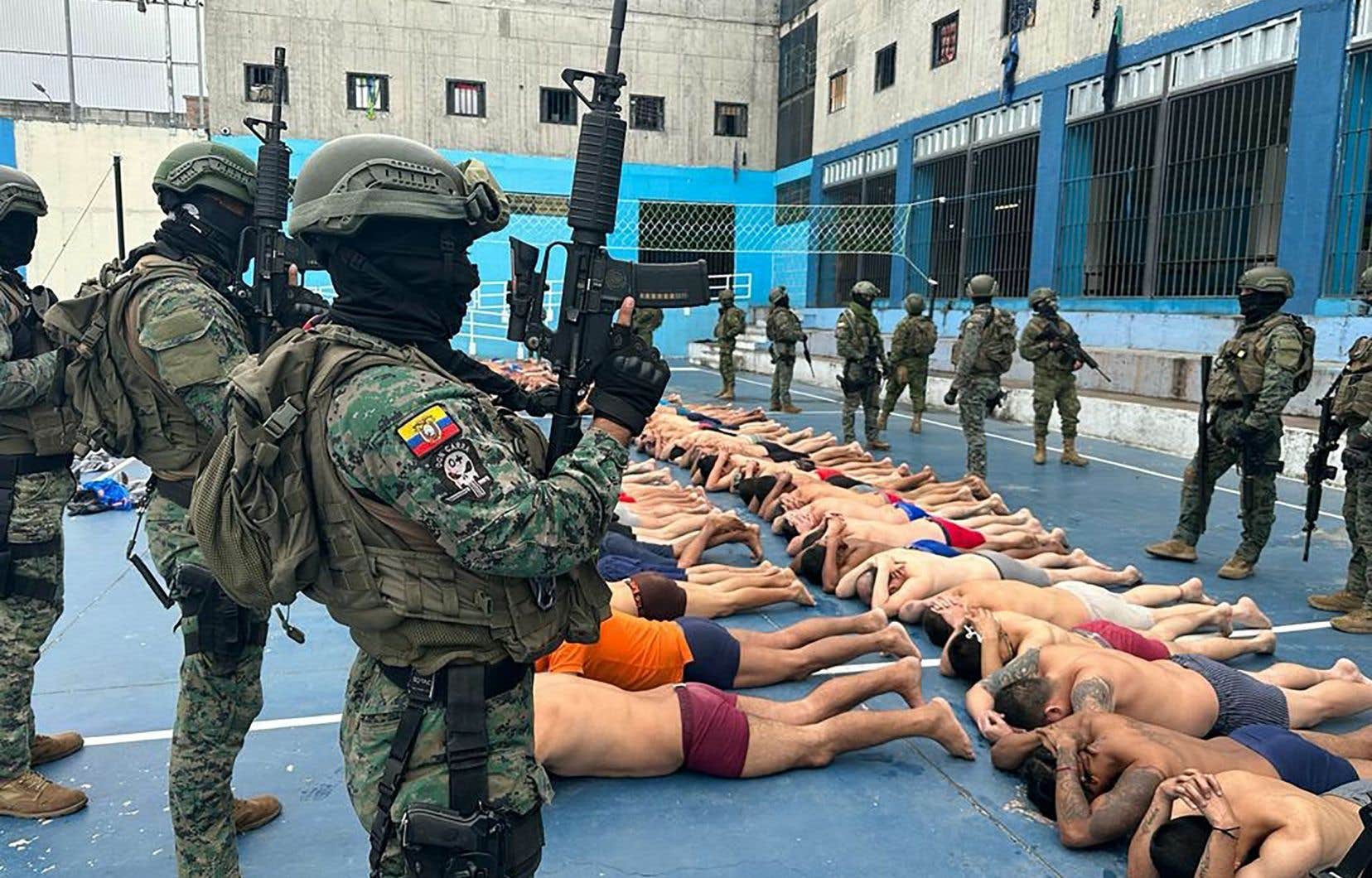The Ecuadorian army and police regained control of several prisons on Sunday and freed more than 200 prison officials held hostage by mutineers, returning the country to some normality after a week of chaos.
Against the backdrop of the “war” opened in recent days between criminal gangs linked to drug trafficking and the security forces, the army released images showing hundreds of detainees lined up with their hands on their heads, bare-chested or in their underwear. , held at gunpoint by soldiers.
Strictly supervised by the soldiers, the prisoners had to sing the national anthem, in close ranks at the foot of the Ecuadorian flag.
According to General Pablo Velasco, “control has been reestablished in six centers” of detention, and an operation is “in progress” in a final prison in the southern province of Cotopaxi.
“ [Il n’y a pas eu] All right […]the military intervention was subsequent to the release” of the hostages, said General Velasco.
This nationwide operation was launched a few hours after the announcement of the release of 136 guards and other officials taken hostage by the mutineers.
The prison administration (SNAI) announced that “the joint action of the police and the army allowed the release of all the hostages who were held in different prisons in the country”.
But according to the latest press release on Sunday evening, the new toll of released prisoners stands at 201.
President Daniel Noboa welcomed on X the “release” of the hostages and said “continue working to restore peace”.
Images released by police showed the guards, including many women, in tears, exhausted and supported by their colleagues shortly after their release.
“Thank God we all came out okay. We are in good health,” the freed hostages from Cotopaxi said in another video on social media, waving an Ecuadorian flag.
For a week, hostages, knives to their throats or guns to their heads, have been calling on the authorities for help and restraint, in videos broadcast on the networks. At least two of them, one of whom was hanged, were executed by the mutineers, according to gruesome images.
The SNAI reported on Saturday the death of a guard during clashes with detainees in the province of El Oro (southwest, bordering Peru), bringing the overall toll of a week of terror to 19 deaths, among including civilians, prison guards, police officers and prisoners, according to the latest official report.
Back to normal
Throughout these hostage situations, the prison administration gave very few details, with security forces confronting mutinous prisoners in some penitentiaries and negotiating in others.
Around forty prison administration officials were released on Saturday, with the authorities citing mediation by the Catholic Church.
The announcement of the escape on January 7 from the Guayaquil complex (southwest) of the feared leader of the Choneros gang Adolfo Macias, alias “Fito”, provoked a wave of mutinies with hostage-taking in at least five prisons , attacks against law enforcement and other acts aimed at sowing terror.
President Daniel Noboa declared a state of emergency and ordered the army to neutralize these criminal gangs, now considered “terrorists”.
More than 22,400 troops were deployed, with land, air and sea patrols, while a curfew was imposed.
After a wave of panic throughout Ecuador caused by the live attack Tuesday on the studios of a public television channel in Guayaquil, the epicenter of drug trafficker violence, the situation has returned to relative normality.
This is the case, during the day, in Guayaquil as in Quito, the capital, even if Ecuadorians quickly return to the safety of their homes at the end of the afternoon.
Once a haven of peace, Ecuador has in recent years become the shipping center for cocaine produced in its Colombian and Peruvian neighbors.
Drug traffickers have gradually imposed their law in this country, given over to the violence of criminal gangs. Ecuadorian prisons, overcrowded and divided into sections controlled by gangs, are regularly the scene of massacres between these rival gangs: Choneros (those from Chone, a town in western Ecuador), Tiguerones (Tigers), Lobos (those from Chone, a town in western Ecuador), Tiguerones (Tigers), Lobos (those from Chone, a town in western Ecuador), Tiguerones (Tigers), Lobos (those from Chone, a town in western Ecuador), Tiguerones (Tigers), Lobos (those from Chone, a town in western Ecuador), Tiguerones (Tigers), Lobos (those from Chone, a town in western Ecuador), Tiguerones (Tigers), Lobos (those from Chone, a town in western Ecuador), Tiguerones (Tigers), Lobos (those from Chone, a town in western Ecuador). Wolves) and other Aguilas (Eagles).
Daniel Noboa, 36, was elected last November as the youngest president in the history of Ecuador on the promise of restoring security.
His predecessor, the conservative Guillermo Lasso, was confronted with several bouts of violence in prisons and declared a state of emergency more than once, without managing to regain control of the situation and more generally to stem trafficking. drugs, linked to corruption, which is blighting the country.
